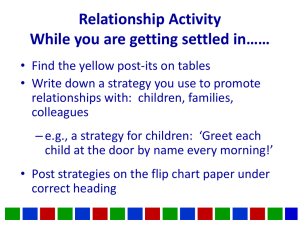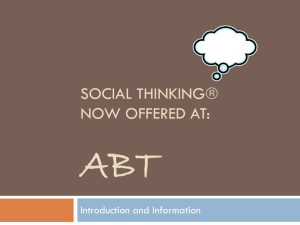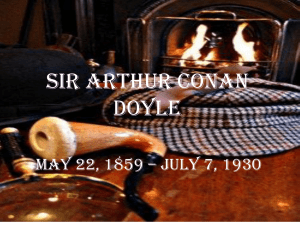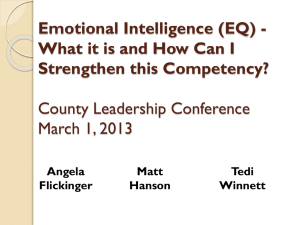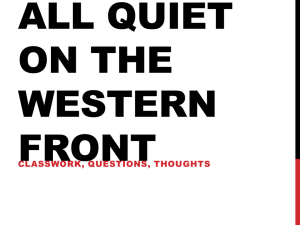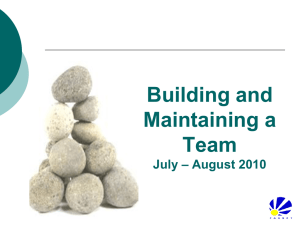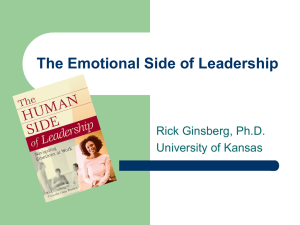Targeted Supports - North Carolina Early Learning Network
advertisement
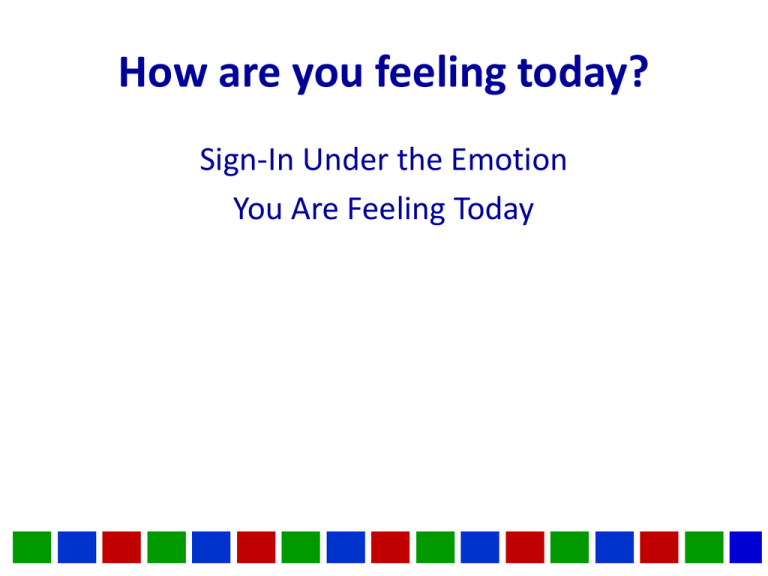
How are you feeling today? Sign-In Under the Emotion You Are Feeling Today Social-Emotional Foundations for Early Learning (SEFEL) Pyramid Model: Teaching Strategies Office of Early Learning Department of Public Instruction April 18 & 19, 2013 Social-Emotional Foundations for Early Learning (SEFEL) Pyramid Model Tier 3:Individualized Positive Behavior Support- Children with persistent challenges Tier 2-Social Skills CurriculaChildren at Risk Tier 1 – High Quality Early Education-All Children 3 Objectives—Day 2 Learn strategies for teaching • Emotional literacy • How to recognize emotions • How to regulate emotions The Teaching Pyramid Social Emotional Teaching Strategies Prevention Creating Supportive Environments Universal promotion Positive Relationships with Children, Families, and Colleagues 5 Social Emotional Teaching Strategies • Enhancing Emotional Literacy • Developing Emotional Regulation • Developing Problem Solving Skills • Developing Friendship Skills 6 Social Emotional Teaching Strategies Emotional Literacy • Think about your definition of emotional literacy • Share with your small group • Come to consensus and write definition • Team shares definition Emotional Literacy The ability to recognize, label, and understand feelings in one’s self and others. Feeling Words Challenge! • How many words can you think of that express emotions? • Write them down • You have 30 seconds! Enhancing Emotional Literacy • Direct/Intentional Teaching Strategies Feeling Faces Feeling Charts Labeling Emotions/Experiences • Literacy Book Nook Feeling Faces 12 Conscious Discipline 13 Checking In 14 Sample Game Make a _____ face. 15 Concentration 16 Feeling Dice/Feeling Wheel Recognizing Emotions Individualizing Emotions Feelings Book with Photos Doyle Woodall – Johnston County Schools Recognizing Feelings – Mirrors and Faces Doyle Woodall – Johnston County Schools Feeling Chart Jessy Hendley -- Cabarrus County Schools Feelings Chart Norma Jannone-Moore County Schools Teaching Feelings Jessy Hendley -- Cabarrus County Schools 24 Break Make & Take Activity • Choose activity • Make a – Feelings Check-In – Feelings Ring • Follow directions at activity station Feelings Check-In Use of Children’s Literature to Support Social Emotional Skills 28 Choosing Books to target specific social emotional skills • Balance heavy and light experiences • Look for books that help develop; empathy and understanding for another person’s feelings respect for their worth (self worth) respect for other’s sincerity and spontaneity Additional things to remember when choosing Books to include Social Emotional Skills • Improve listening comprehension • Develop literacy and vocabulary • Provide relevant examples of how to use the skill and what to do in peer interactions • Help children relate to the emotions of the characters • Encourage children to pay attention to their own actions • Should be able to be generalized and practiced in school, home and neighborhood • Refer back to increase memory and problem solving skills in addition to language skills. Books • • • • • • • • Culturally diverse Link behavior to emotions Avoid violence Simple and clear story lines Brief and easy to comprehend Non stereotypical Demonstrate control of impulsive behavior Help students recognize that others may experience situations differently from oneself Books • Explain why unprovoked acts that hurt others is wrong • Help students understand that there are different choices for decisions • Have emotional content • Use vibrant illustrations and original • Introduce words to help children categorize feelings into words. • Should relate to a relationship that students can understand. Emotional Social Competency Skills addressed through Literature • Behavior traits to include in instruction; Citizenship Respect Compassion Responsibility Honesty Effort Self-control Positive attitude Pete The Cat http://www.youtube.com/watch?v=nUubMSfIs-U Activity • Choose a book on your table. • Share the book with one other person at your table • Use the handout to discuss how you might use this book with your class and what social emotional skill(s) you might target. • Share your ideas with the large group Book Nooks http://www.csefel.uiuc.edu/practical-ideas.html On Monday When it Rained Glad Monster Sad Monster Hands Are Not for Hitting 36 Lisa Bruggeman – Asheville City Schools Video - Jenna 38 Lunch Social Emotional Teaching Strategies Emotional Regulation Emotional Regulation The ability to express a range of emotions and react in appropriate ways in emotional situations. Strategies for Teaching Emotional Regulation • • • • • Teach tense/stressed & relaxed Safe space Three deep breaths/Tucker Relaxation Thermometer Calming Choice Board Body Language Center on the Social and Emotional Foundations for Early Learning 43 Cozy Corner Jessy Hendley -- Cabarrus County Schools Safe Space Lisa Bruggeman – Asheville City Schools Safe Space Materials Lisa Bruggeman – Asheville City Schools Safe Place Norma Jannone-Moore County Schools Tucker the Turtle Center on the Social and Emotional Foundations for Early Learning 48 Tucker the Turtle! Doyle Woodall – Johnston County Schools Tucker Book and Puppet Jessy Hendley -- Cabarrus County Schools Social Emotional Teaching Strategies Problem Solving Skills Problem Solving Steps Step 2 Center on the Social and Emotional Foundations for Early Learning 52 •Would it be safe? •Would it be fair? •How would everyone feel? 53 The Solution Kit 54 Solutions! Doyle Woodall – Johnston County Schools Solutions Kit Lisa Bruggeman – Asheville City Schools Video – Using the Solution Kit 57 Social Emotional Teaching Strategies Friendship Skills • Organizing play • Sharing toys & other materials • Taking turns • Being helpful • Giving compliments • Understanding how & when to give an apology Center on the Social and Emotional Foundations for Early Learning Social Skills Impact Friendship Skills Developing Social Skills that Impact Friendship Skills Develop Eye Contact Staring contest Pair of eyes on forehead Swinging-reach you with his feet Books about Idioms Use idioms in conversation (That’s a piece of cake!) www.friendshipcircle.org Games to develop friendship skills • Memory or Matching Games Face it-try mirroring –have the children touch their nose when you touch yours, stick out tongue etc. Topic Game- play a game with alphabet where every letter has to begin with a theme…such fruit…A...apple, B…Banana • Emotion Charades – Use pictures of emotions, have children draw a picture, then act out the emotion www.friendshipcircle.org Conversation • Step into a conversation Scripted stories on entering a conversation Practice Stand, Look, Talk, Listen • Improvisational Storytelling Make up stories using emotion cards…one child begins the story and others add to the story. www.friendshipcircle.org Impact of Social Skills On Friendships Positive • Starting Conversationsharing • Taking turns-asking for what one wants or needs • Expressing feelingsapologizing to others • Asking questions-following the rules of play Negative • Physical Aggression-poor loser • Arguing-getting into others’ space • Interrupting-talking too much • Name calling-breaking rules of play www.kidsmatter.edu.au Friendship Activity • Brainstorm strategies for building friendship skills in daily schedule • List strategies and activities developed by the group on large sticky notes with identified schedule area • Choose a group spokesperson to share 2 or 3 strategies with the large group 65 Break Buddy Activity Jessy Hendley -- Cabarrus County Schools 67 Friendship Art Doyle Woodall – Johnston County Schools Teaching Positive Interactions Lisa Bruggeman – Asheville City Schools Using Positive Interactions Lisa Bruggeman – Asheville City Schools Cooperation Lisa Bruggeman – Asheville City Schools Developing Friends Lisa Bruggeman – Asheville City Schools Friends Making Kindness Mittens Norma Jannone-Moore County Schools 73 Super Friends Bulletin Board Doyle Woodall – Johnston County Schools Super Friend Board Jessy Hendley -- Cabarrus County Schools Super Friend Board Lisa Bruggeman – Asheville City Schools Video –Super Friends Additional Resources • • • • • • • • Second Step Social Stories Conscious Discipline Incredible Years Dr. Jean Pete the Cat Board Maker Songs and Music Second Step 79 Scripted Stories • A written script for the child about social situations and expectations. • The script is written from the child’s perspective. • The script is descriptive, perspective, and directive. • The script is written to match the child’s functional and developmental level. 80 What Do We Do In Circle? Created by Rochelle Lentini, USF Adapted 2004 Created using pictures from Microsoft Clipart®and Boardmaker® I Go to Preschool Created by Rochelle Lentini, USF Adapted 2004 82 Social Stories http://tarheelreader.org/ 83 The Teaching Pyramid Social Emotional Teaching Strategies Prevention Creating Supportive Environments Universal promotion Positive Relationships with Children, Families, and Colleagues 84 System-Wide Implementation 2 - 4 Years Exploration Assess needs Examine innovations Examine Implementation Assess fit Installation Acquire resources Prepare organization Prepare implementation Prepare staff Initial Implementation Full Implementation Implementation Implementation drivers Manage change Data systems Improvement cycles drivers Implementation outcomes Innovation outcomes Standard practice NC-DPI SEFEL 86 SEFEL ListServ TO JOIN: You will need to return an e-mail with the subject line, SEFEL Listserv, To: Dave Sanel at david.sanel@unc.edu Include the following in the body of the e-mail: Name Title Organization E-Mail Work Phone 87 Questions 88
